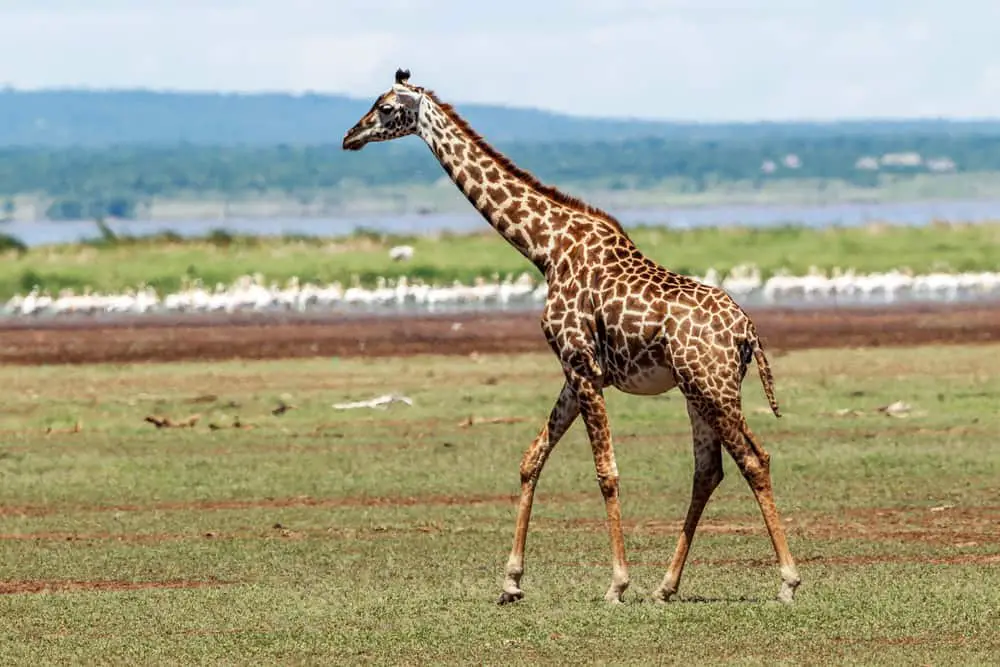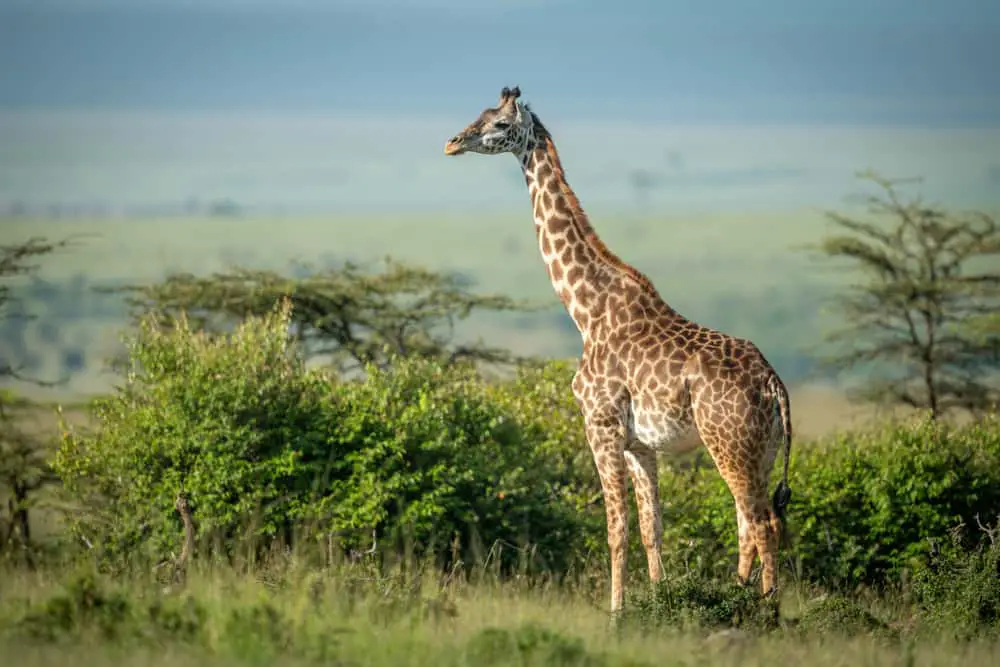Masai giraffe (Giraffa tippelskirchi) are the largest of all living species of Giraffidae, and have a distinctive ragged coat pattern.
They inhabit the savanna woodlands in East Africa stretching from Kenya to Tanzania.
The Masai giraffe is an iconic animal that has been studied for many years and offers scientists valuable insight into the behavior and adaptation of this species.
This article will discuss various aspects of the Masai giraffe’s ecology, including their distribution range, diet preferences, social structure, and conservation status.

Distribution Range
The Masai Giraffe is an iconic species of African savanna, yet their range and population dynamics are threatened by habitat fragmentation.
This impressive member of the giraffe family has a unique patterning that distinguishes it from other giraffes—their coats feature large blotches with star-like extensions on a cream or yellow background.
Masai Giraffes can be found in East Africa, primarily in Kenya and Tanzania. They inhabit both open grasslands as well as acacia woodlands, which offer them shelter from predators and provide access to food resources such as leaves and buds.
As human populations have increased around these habitats, there has been increasing pressure for land conversion into agricultural zones. Consequently, this has led to significant declines in suitable Masai Giraffe habitats, resulting in fragmented populations across much of its range.
In order to understand the impacts of habitat fragmentation on population dynamics, detailed research projects must be undertaken to examine how these changes affect individual populations over time.
Diet Preferences
Masai giraffes have a distinct diet that is based on their foraging patterns. As browsers, they are opportunistic feeders, meaning they take advantage of the food availability in whatever habitat they inhabit.
It has been observed that Masai giraffe show an affinity to browse in more than one area within the same day and may even return to those areas over multiple days or weeks. The main components of their diet consist of leaves, shoots, bark and fruits from Acacia trees as well as Commiphora bushes. They also consume herbs and grasses when available although this forms only a small part of their overall dietary intake.
Studies have shown that Masai giraffes often move between different habitats throughout the year depending on seasonal changes in food availability. During times of low resource abundance, such as long dry periods, many individuals will migrate from woodlands into open plains where there are fewer competitors for resources. Here they will eat various green vegetation including shrubs and herbs found on the ground level.
This behaviour highlights how essential it is for them to adapt to limited food sources by travelling large distances in order to maintain optimal nutrition levels.
Social Structure
Masai giraffes are known for their intricate social structures and herd dynamics. They communicate with each other through a series of visual and tactile signals, often referred to as the ‘giraffe language.’
The masai giraffe population is usually made up of:
- Females: These giraffes typically form small herds consisting of related individuals or family members. Herds can be comprised of as many as seven females and calves, who live together in harmony while sharing resources and food.
- Males: Male masai giraffe groups may contain anywhere from one to five individuals, but they tend to stay separate from female groups until it’s time to mate. During mating season, males compete fiercely against one another in order to impress potential mates.
In addition, there have been reports of male giraffes forming alliances that help them secure females during courtship. This alliance behavior has only been observed among young adult male masai giraffes; older males prefer to court alone instead.
Understanding how these relationships affect herd dynamics reveals valuable insights into the species’ natural behaviors and communication patterns.
Reproductive Habits
Masai giraffes are a species of African ungulate that have distinct mating rituals and birthing processes. As with any type of animal, understanding the reproductive habits of masai giraffes is essential to their conservation and protection.
The mating ritual for masai giraffes has been studied in depth by researchers and experts. They typically mate between December and July, with males competing for females during this period. A male will often court a female by rubbing his neck against hers or licking her body parts before attempting to mount her from behind. The gestation period for these animals can range from 14-15 months, after which the mother gives birth standing up either alone or surrounded by other members of the herd.
| Behavior | Frequency | Purpose |
|---|---|---|
| Neck Rubbing | Occasional | Courtship |
| Licking | Frequent | Courtship |
| Mounting | Attempted Once | Mating |
| Gestation | 14-15 Months | Birthing Process |
| Birth Standing | 1 Time Per Pregnancy | Birthing Process |
Once born, calves remain close to their mothers until they reach sexual maturity at around 3 years old. Masai giraffe adolescents continue to rely on parental guidance even after reaching adulthood as there is still much for them to learn about surviving in their habitat and avoiding predators such as lions, cheetahs, leopards, hyenas, and wild dogs. With proper education, knowledge sharing among stakeholders, and increased awareness surrounding reproduction practices within this species’ population, it is possible to ensure its continued survival over time.
Predators And Threats
The masai giraffe is a majestic creature, reminiscent of a regal king surveying his kingdom. Its environment, however, has been under threat due to human activities such as:
- Habitat loss which results from deforestation and urbanization
- Climate change leading to changes in the availability of food sources
- Poaching for their meat or hide
- Diseases spread by domestic livestock herds
- Human-wildlife conflict resulting in retaliatory killings
These threats have caused populations of masai giraffes to decrease significantly over the past few decades. Conservation efforts such as protected areas where they are safe from poaching and other forms of harm have helped increase their numbers.
Additionally, education campaigns that raise awareness among local communities about the importance of preserving these animals can help protect them against habitat destruction and illegal hunting. With concerted effort and support from global stakeholders, we may be able to save this species before it becomes extinct.
Conservation Status
The conservation status of the Masai giraffe is an important issue that needs to be addressed.
Large populations are still found in Kenya and Tanzania, though they have declined significantly due to habitat destruction and fragmentation as a result of human activity such as agricultural expansion, illegal poaching, and human-wildlife conflict.
As their natural habitats shrink, so do opportunities for them to find food and water sources necessary for survival.
These threats also lead to genetic isolation among herds, which increases the risk of extinction.
Additionally, Masai giraffes face competition from other herbivores like buffalo for resources in protected areas.
It is essential that effective initiatives are implemented to protect existing wild population numbers and prevent further decline through improved land management practices, law enforcement efforts against poachers, and reducing human-wildlife conflicts by creating buffer zones between humans and wildlife.
Conservationists must take action now if we wish to ensure the future of this majestic species.

Adaptive Mechanisms
The conservation status of the masai giraffe is a challenge that has been met with both success and failure. While some populations are thriving, others have seen significant declines due to habitat loss and poaching.
However, while conservation efforts remain an important part of ensuring the species’ survival, attention must also be paid to the adaptive strategies they use to continue living in their rapidly changing environment.
Masai giraffes demonstrate remarkable adaptability through several key mechanisms. To begin with, they possess intricate foraging strategies which allow them to make full use of available resources and minimize competition. Additionally, these animals employ complex communication signals like head-nodding and tail-swishing as subtle indicators of interspecies interactions or danger warnings between members of their own herd. Moreover, studies have shown that masai giraffes can quickly adjust their diet when food sources become scarce or diminished.
This adaptability is essential for the long-term survival of this iconic African species especially given its declining population numbers in many areas across East Africa. Therefore it is imperative that we do our utmost to protect these beautiful animals from further decline by providing them with adequate space and resources needed to flourish over time.
Role In The Ecosystem
The role of the Masai giraffe in its ecosystem is an important one. As a large, herbivorous mammal, it plays a vital part in regulating vegetation growth within its habitat. Without the presence of this species, there could be severe ecological consequences on the local environment and other wildlife that share its home range.
In addition to controlling plant populations, Masai giraffes also serve as prey for many predators such as lions and hyenas; their presence helps to maintain balance within ecosystems. Unfortunately, due to human activities such as deforestation and habitat fragmentation caused by climate change, these animals are becoming increasingly threatened.
The loss of suitable habitats can lead to population decline, which in turn affects not only the individual animal but also the entire ecosystem they inhabit. It is therefore essential that conservation efforts continue to protect these magnificent creatures and ensure the stability of their habitats into the future.
Conclusion
Masai giraffes are an iconic African species, and they play a vital role in the continent’s ecosystems.
Though their range has become more fragmented due to human development, conservation efforts have been successful in some areas.
For example, Masai Giraffe populations increased by 20% between 2007 and 2018 in Kenya’s Mara Triangle thanks to dedicated protective measures implemented there that year.
These measures are providing a model for other regions of Africa where Masai Giraffes still roam wild.
It is our responsibility as humans to protect these majestic animals so that generations can continue to marvel at them in the future.
